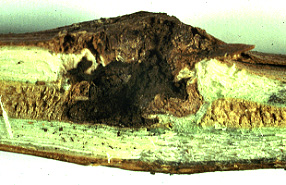
Grape cane gallmaker, Ampeloglypter sesostris
(LeConte)
This is taken primarily from an extension
bulletin
by D. G. Pfeiffer & P. B. Schultz, entitled "Major Insect and Mite
Pests of Grape in Virginia" (Va. Coop. Ext. Serv. 444-567 (1986))
This weevil is closely related to the grape
cane girdler and is similar in many respects in appearance and life
cycle. The species is red-brown rather than black. The main difference
is in the biology of this species: the female punctures the shoot just
above one of the lower joints and places an egg in the puncture. There
are additional punctures above this in which no eggs are laid. As the
larva
feeds in the pith, a red gall or swelling develops in the area. The
gall
is 2.5-5 cm long, about twice the diameter of the cane. The cane may
break
at this point when green, but after it hardens it will usually survive
to produce a crop the next season. The cane still grows, so damage is
usually
not important even though this species may be a common pest. Infested
canes
may be destroyed as soon as the swellings are visible.
Recent research in Pennsylvania has shown no
effect
on berry quality or vine vigor (Saunders and Tobin 2000).
See New York Fact
sheet
Other reading:
Saunders, M. C. and P. C.
Tobin.
2000. Grape cane gallmaker (Coleoptera: Curculionidae) and its impact
on
cultivated grapes. J. Econ. Entomol. 93: 795-799.
Back to Virginia
Vineyard
page
Back to Virginia
Fruit Page